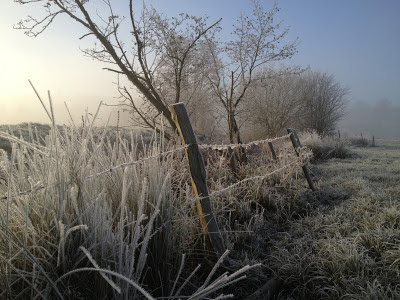On a beautiful clear and frosty morning I took a break from the DIY and helping with pre-Christmas dinner party organisation to wander the local patch from Sadler's Mill to Squabb Wood on the outskirts of Romsey. The morning was truly stunning with a hoar frost encrusting the trees and the River Test steaming as though I had been transported to the winter geysers of Yellowstone Park.
River Test Between Sadler's Mill and Squabb Wood, Romsey
(all pictures taken on my iPhone)
Although my birding here is in its infancy it was nice to get four patch-ticks in a couple of hours with snipe and treecreeper not providing any great surprises as they snuck onto the list. Goosander on the other hand was a nice bird to add with an adult male and an immature male on the River Test and, finally, a woodcock being flushed from the edges of Squabb Wood. Woodcock are stunning birds when seen close at hand with their cryptic, bracken toned plumage and large dark eye set at the top of the head for near 360 degree vision.
Woodcock
(photo from How Hill Trust http://howhilltrust.org.uk)
The woodcock breeds throughout much of the UK at low density but it is in autumn, when our resident (and largely sedentary) birds are supplemented by a large influx of migrants from Fennoscandia and Russia, that many birders connect with this species. Most woodcock are encountered as they are flushed from damp woodland floors but also regularly from more unusual habitats shortly after they arrive on our east coasts - for example, birds can be encountered in sand dunes, on shingle beaches and even urban parks and gardens. It has been estimated that around 800,000 woodcock migrate to the UK in the autumn and winter months. Migrants usually start arriving during the second week of October with large falls often said to occur around the time of the full moon in late October and particularly in November, the latter being regarded as 'the woodcock moon'.
Finally, mammals were much in evidence with roe and fallow deer in Squabb Wood, a water vole showing well in one of the ditches that cross my regular birding route and, best of all, an otter seen all to briefly as it splashed after fish on the margins of the River Test then a view of its head followed by its tail held erect as it dived and swam, unseen, to safety.
Finally, mammals were much in evidence with roe and fallow deer in Squabb Wood, a water vole showing well in one of the ditches that cross my regular birding route and, best of all, an otter seen all to briefly as it splashed after fish on the margins of the River Test then a view of its head followed by its tail held erect as it dived and swam, unseen, to safety.






